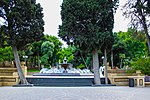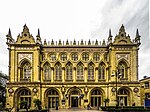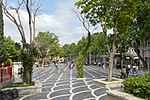Monument to Nizami Ganjavi in Baku
The Monument to Nizami Ganjavi, a medieval Persian poet, is located in Baku in Nizami Square, on the intersection of Istiglaliyyat, Ahmad Javad, Azerbaijan and Islam Safarli streets. The opening ceremony of the monument was held in April 1949. The sculptor of the monument was Fuad Abdurahmanov, People’s Artist of Azerbaijan.The monument is a 6-meter high bronze statue installed on 9-meter high octahedral pedestal. The pedestal is of red Labrador, and elements of Azerbaijani architecture of Nizami’s epoch were used in its handling. There is an ornamental carving and faced bronze plates on the lower part of the monument. Seven plates feature scenes from Nizami's works, and one plate displays a memorial inscription.
Excerpt from the Wikipedia article Monument to Nizami Ganjavi in Baku (License: CC BY-SA 3.0, Authors).Monument to Nizami Ganjavi in Baku
Istiglaliyat street, Baku City
Geographical coordinates (GPS) Address Nearby Places Show on map
Geographical coordinates (GPS)
| Latitude | Longitude |
|---|---|
| N 40.3696 ° | E 49.8352 ° |
Address
Nizami Gəncəvi heykəli
Istiglaliyat street
1095 Baku City (Sabail Raion)
Baku, Azerbaijan
Open on Google Maps











